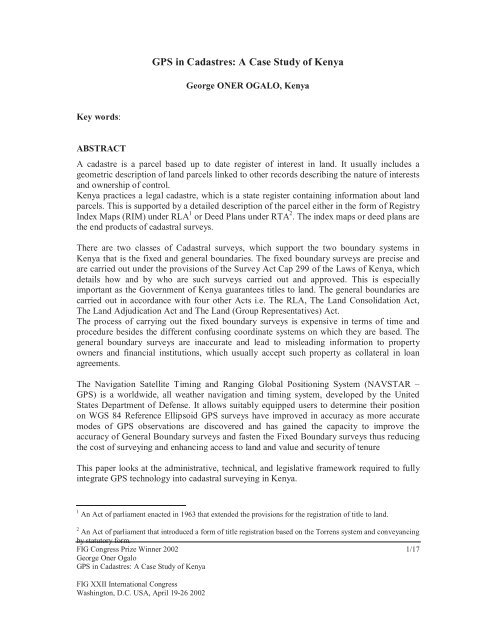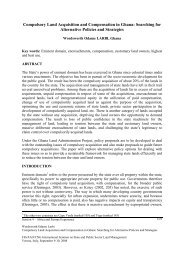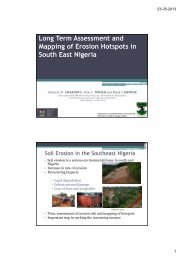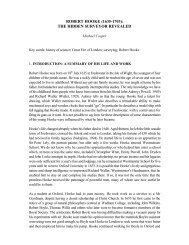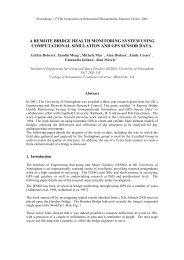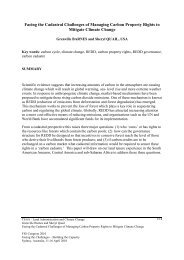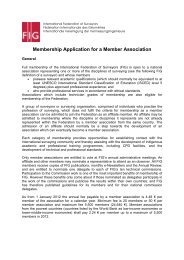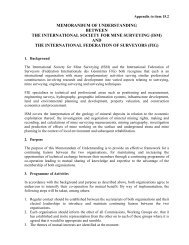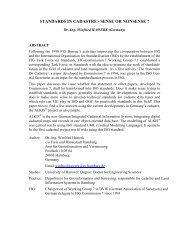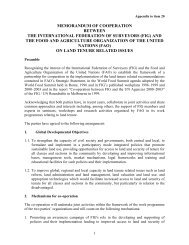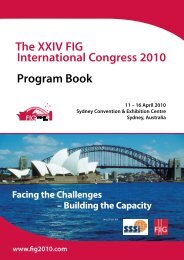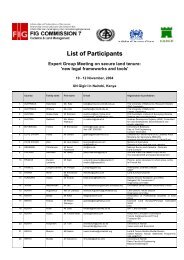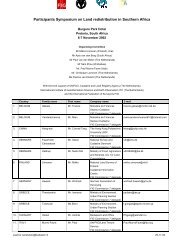GPS in Cadastres: A Case Study of Kenya - FIG
GPS in Cadastres: A Case Study of Kenya - FIG
GPS in Cadastres: A Case Study of Kenya - FIG
You also want an ePaper? Increase the reach of your titles
YUMPU automatically turns print PDFs into web optimized ePapers that Google loves.
Key words:<br />
by statutory form.<br />
<strong>FIG</strong> Congress Prize W<strong>in</strong>ner 2002<br />
George Oner Ogalo<br />
<strong>GPS</strong> <strong>in</strong> <strong>Cadastres</strong>: A <strong>Case</strong> <strong>Study</strong> <strong>of</strong> <strong>Kenya</strong><br />
<strong>FIG</strong> XXII International Congress<br />
Wash<strong>in</strong>gton, D.C. USA, April 19-26 2002<br />
<strong>GPS</strong> <strong>in</strong> <strong>Cadastres</strong>: A <strong>Case</strong> <strong>Study</strong> <strong>of</strong> <strong>Kenya</strong><br />
George ONER OGALO, <strong>Kenya</strong><br />
ABSTRACT<br />
A cadastre is a parcel based up to date register <strong>of</strong> <strong>in</strong>terest <strong>in</strong> land. It usually <strong>in</strong>cludes a<br />
geometric description <strong>of</strong> land parcels l<strong>in</strong>ked to other records describ<strong>in</strong>g the nature <strong>of</strong> <strong>in</strong>terests<br />
and ownership <strong>of</strong> control.<br />
<strong>Kenya</strong> practices a legal cadastre, which is a state register conta<strong>in</strong><strong>in</strong>g <strong>in</strong>formation about land<br />
parcels. This is supported by a detailed description <strong>of</strong> the parcel either <strong>in</strong> the form <strong>of</strong> Registry<br />
Index Maps (RIM) under RLA 1 or Deed Plans under RTA 2 . The <strong>in</strong>dex maps or deed plans are<br />
the end products <strong>of</strong> cadastral surveys.<br />
There are two classes <strong>of</strong> Cadastral surveys, which support the two boundary systems <strong>in</strong><br />
<strong>Kenya</strong> that is the fixed and general boundaries. The fixed boundary surveys are precise and<br />
are carried out under the provisions <strong>of</strong> the Survey Act Cap 299 <strong>of</strong> the Laws <strong>of</strong> <strong>Kenya</strong>, which<br />
details how and by who are such surveys carried out and approved. This is especially<br />
important as the Government <strong>of</strong> <strong>Kenya</strong> guarantees titles to land. The general boundaries are<br />
carried out <strong>in</strong> accordance with four other Acts i.e. The RLA, The Land Consolidation Act,<br />
The Land Adjudication Act and The Land (Group Representatives) Act.<br />
The process <strong>of</strong> carry<strong>in</strong>g out the fixed boundary surveys is expensive <strong>in</strong> terms <strong>of</strong> time and<br />
procedure besides the different confus<strong>in</strong>g coord<strong>in</strong>ate systems on which they are based. The<br />
general boundary surveys are <strong>in</strong>accurate and lead to mislead<strong>in</strong>g <strong>in</strong>formation to property<br />
owners and f<strong>in</strong>ancial <strong>in</strong>stitutions, which usually accept such property as collateral <strong>in</strong> loan<br />
agreements.<br />
The Navigation Satellite Tim<strong>in</strong>g and Rang<strong>in</strong>g Global Position<strong>in</strong>g System (NAVSTAR –<br />
<strong>GPS</strong>) is a worldwide, all weather navigation and tim<strong>in</strong>g system, developed by the United<br />
States Department <strong>of</strong> Defense. It allows suitably equipped users to determ<strong>in</strong>e their position<br />
on WGS 84 Reference Ellipsoid <strong>GPS</strong> surveys have improved <strong>in</strong> accuracy as more accurate<br />
modes <strong>of</strong> <strong>GPS</strong> observations are discovered and has ga<strong>in</strong>ed the capacity to improve the<br />
accuracy <strong>of</strong> General Boundary surveys and fasten the Fixed Boundary surveys thus reduc<strong>in</strong>g<br />
the cost <strong>of</strong> survey<strong>in</strong>g and enhanc<strong>in</strong>g access to land and value and security <strong>of</strong> tenure<br />
This paper looks at the adm<strong>in</strong>istrative, technical, and legislative framework required to fully<br />
<strong>in</strong>tegrate <strong>GPS</strong> technology <strong>in</strong>to cadastral survey<strong>in</strong>g <strong>in</strong> <strong>Kenya</strong>.<br />
1 An Act <strong>of</strong> parliament enacted <strong>in</strong> 1963 that extended the provisions for the registration <strong>of</strong> title to land.<br />
2 An Act <strong>of</strong> parliament that <strong>in</strong>troduced a form <strong>of</strong> title registration based on the Torrens system and conveyanc<strong>in</strong>g<br />
1/17
CONTACT<br />
George Oner Ogalo,<br />
Graduate Surveyor,<br />
Geometer Surveys Ltd.<br />
Box 53387<br />
Nairobi<br />
KENYA<br />
Tel. + 254 02 253370/500903<br />
E-mail: geometer@bidii.com or ogalooner@yahoo.com<br />
<strong>FIG</strong> Congress Prize W<strong>in</strong>ner 2002<br />
George Oner Ogalo<br />
<strong>GPS</strong> <strong>in</strong> <strong>Cadastres</strong>: A <strong>Case</strong> <strong>Study</strong> <strong>of</strong> <strong>Kenya</strong><br />
<strong>FIG</strong> XXII International Congress<br />
Wash<strong>in</strong>gton, D.C. USA, April 19-26 2002<br />
2/17
1 INTRODUCTION<br />
<strong>FIG</strong> Congress Prize W<strong>in</strong>ner 2002<br />
George Oner Ogalo<br />
<strong>GPS</strong> <strong>in</strong> <strong>Cadastres</strong>: A <strong>Case</strong> <strong>Study</strong> <strong>of</strong> <strong>Kenya</strong><br />
<strong>FIG</strong> XXII International Congress<br />
Wash<strong>in</strong>gton, D.C. USA, April 19-26 2002<br />
<strong>GPS</strong> <strong>in</strong> <strong>Cadastres</strong>: A <strong>Case</strong> <strong>Study</strong> <strong>of</strong> <strong>Kenya</strong><br />
George ONER OGALO, <strong>Kenya</strong><br />
1.1 Land <strong>in</strong> <strong>Kenya</strong><br />
The Republic <strong>of</strong> <strong>Kenya</strong> has an area <strong>of</strong> 582,646 sq. Km and a population <strong>of</strong> over 28 million<br />
(1999 Census). 75% <strong>of</strong> the population occupies approximately 20% <strong>of</strong> the country considered<br />
high or medium potential and the rural community constitutes 80% <strong>of</strong> the country’s<br />
population. Land <strong>in</strong> <strong>Kenya</strong> is categorized <strong>in</strong>to government (10%), trust (70%) and private<br />
(20%) lands (Mwenda, 2001).<br />
The Government land consists <strong>of</strong> all that land vested the crown by the Crown Lands<br />
Ord<strong>in</strong>ance (CLO) <strong>of</strong> 1902, enacted by the British government, less any land granted <strong>in</strong>to<br />
private ownership by that ord<strong>in</strong>ance or the Government Lands Act (GLA) Cap 280 <strong>of</strong> 1915.<br />
Currently, GLA regulates the leas<strong>in</strong>g and disposition <strong>of</strong> this land. GLA was enacted to<br />
replace the alienation aspects <strong>of</strong> the CLO and the registration aspects <strong>of</strong> the Registration <strong>of</strong><br />
Documents Act (RDA) <strong>of</strong> 1902 (Macoco, 1999). This is the act that <strong>in</strong>troduced <strong>in</strong>to <strong>Kenya</strong><br />
the advanced registration <strong>of</strong> deeds and provided for an accurate survey as well as the 99 and<br />
999-year leases.<br />
Due to the high level <strong>of</strong> landlessness and desperate squatter situation that prevailed as a result<br />
<strong>of</strong> the CLO and the GLA towards 1930, the East African Royal Commission (1925) and the<br />
Carter Commission (1933) recommended the creation <strong>of</strong> Trust Lands exclusively for the use<br />
<strong>of</strong> Africans as far as ownership was concerned, but the authority <strong>of</strong> use was still vested <strong>in</strong> the<br />
local authorities or county councils (Wayumba 1987). Thus, the trust lands comprise all that<br />
land held <strong>in</strong> trust by local councils for the communities ord<strong>in</strong>arily resident <strong>in</strong> those regions as<br />
def<strong>in</strong>ed by the Trust Lands Act, Cap 288 <strong>of</strong> the Laws <strong>of</strong> <strong>Kenya</strong> (Baya, 2000).<br />
Private land constitutes any land successfully claimed and for which a certificate <strong>of</strong> title was<br />
issued under the Land Titles Act (LTA) Cap 282 <strong>of</strong> 1910 <strong>in</strong> the Coast Prov<strong>in</strong>ce, any formerly<br />
Government land alienated with<strong>in</strong> the provisions <strong>of</strong> the Government Lands Act cap 280 or<br />
any land converted to private ownership from the trust lands via sett<strong>in</strong>g apart by local<br />
councils or under the provisions <strong>of</strong> Land Consolidation Act (LCA), Land Adjudication Act<br />
(LAA) or the Land (Group Representatives) Act. The land hold<strong>in</strong>g <strong>in</strong> this category is<br />
currently registered under two ma<strong>in</strong> legislations i.e. the Registered Lands Act (RLA) Cap 300<br />
<strong>of</strong> 1968 and the Registration <strong>of</strong> Titles Act (RTA) Cap 281 <strong>of</strong> 1919. Exceptions are those<br />
registered under the LTA Cap 282 and the RDA Cap 285 <strong>of</strong> the Laws <strong>of</strong> <strong>Kenya</strong> (Macoco,<br />
1999).<br />
In the recent past, there have been calls from pr<strong>of</strong>essionals that recommend a review <strong>of</strong> this<br />
classification <strong>of</strong> land. The Institution <strong>of</strong> Surveyors <strong>of</strong> <strong>Kenya</strong> (ISK) recommends that the<br />
government land be reclassified <strong>in</strong>to State and Public land. The state land should thus cover<br />
all protected areas that are gazetted e.g. for government <strong>in</strong>stallations and property (military<br />
3/17
and civilian), national forests and reserves, parks, water catchment areas etc. The public land<br />
should cover all unalienated government land and land with<strong>in</strong> local authorities, road reserves<br />
and public utility land (I.S.K., 2000)<br />
1.2 Cadastral Survey<strong>in</strong>g <strong>in</strong> <strong>Kenya</strong><br />
Cadastral surveys are the surveys carried out to support registration <strong>of</strong> <strong>in</strong>terest <strong>in</strong> land. They<br />
usually result <strong>in</strong> the preparation <strong>of</strong> the land registration documents and they conform to<br />
different requirements depend<strong>in</strong>g on the registration legislation <strong>in</strong> place.<br />
Cadastral survey<strong>in</strong>g <strong>in</strong> <strong>Kenya</strong> may be traced to the establishment <strong>of</strong> a survey section and the<br />
appo<strong>in</strong>tment <strong>of</strong> a chief surveyor <strong>in</strong> 1903 to super<strong>in</strong>tend the demarcation and survey <strong>of</strong> plots<br />
that had been alienated <strong>in</strong> Nairobi (Njuki, 2001). Major landmarks <strong>in</strong> the cadastral survey<br />
reforms <strong>in</strong> <strong>Kenya</strong> are associated with the different land reform programs <strong>in</strong>itiated over the<br />
years.<br />
Prior to the Second World War, the major land reform programs were the Land adjudication<br />
at the coast and the European settlement on the white highlands. Cadastral surveys concerned<br />
with alienat<strong>in</strong>g crown lands to the white community were done under the provisions <strong>of</strong> the<br />
Survey Ord<strong>in</strong>ance <strong>of</strong> 1923 and registered under the RTA. These surveys were <strong>of</strong> very high<br />
standards, described land unambiguously and resulted <strong>in</strong> very few boundary disputes (Njuki,<br />
1999). The other form <strong>of</strong> surveys was done under the provisions <strong>of</strong> the Land Titles Ord<strong>in</strong>ance<br />
<strong>of</strong> 1908 to demarcate and def<strong>in</strong>e the boundaries <strong>of</strong> both adjudicated and unclaimed land at the<br />
coast. These surveys were done by compass and cha<strong>in</strong> with connections to very few control<br />
po<strong>in</strong>ts and were slow, expensive and <strong>of</strong> low accuracy. Certificate <strong>of</strong> titles were issued for all<br />
adjudicated lands and all unclaimed lands reverted to the crown.<br />
The period after the Second World War to shortly after Independence (1963) saw land<br />
reforms focus on loosen<strong>in</strong>g control to land ownership for the Africans. A series <strong>of</strong><br />
recommendations, factors and events led to the Land Consolidation and Adjudication<br />
programmes which were <strong>in</strong>tended to transform from customary to <strong>in</strong>dividual (Statutory<br />
Freehold) land tenure for Africans <strong>in</strong> regions categorized similarly <strong>in</strong> this period as Trust<br />
Lands. The Land Consolidation programme which <strong>in</strong>volved adjudication and fragment<br />
gather<strong>in</strong>g <strong>of</strong> small plot sizes, worked for some time and the areas <strong>in</strong> which it was<br />
implemented are referred to as Consolidation areas. The land adjudication programme<br />
replaced the land consolidation programme and abandoned the fragment gather<strong>in</strong>g approach.<br />
This programme is still on go<strong>in</strong>g and the areas <strong>in</strong> which it has worked are referred to as<br />
Enclosure areas (Wayumba, 1999). Similarly, there were areas referred to as Rangelands<br />
commonly <strong>in</strong>habited by nomadic pastoral communities <strong>in</strong> which group ownership <strong>of</strong> land was<br />
preferred to <strong>in</strong>dividual. Group ranches were then registered <strong>in</strong> the name <strong>of</strong> group<br />
representatives on behalf <strong>of</strong> the rest <strong>of</strong> the group members under the provisions <strong>of</strong> the Land<br />
(Group Representatives) Act Cap 287 <strong>of</strong> 1968.<br />
Cadastral surveys <strong>in</strong> this period were thus concerned with this endeavor. In consolidation<br />
areas, surveys were done to ascerta<strong>in</strong> the sizes <strong>of</strong> <strong>in</strong>dividual fragments and the general size <strong>of</strong><br />
the adjudication section, to demarcate the replanned plots and to produce the Demarcation<br />
<strong>FIG</strong> Congress Prize W<strong>in</strong>ner 2002<br />
George Oner Ogalo<br />
<strong>GPS</strong> <strong>in</strong> <strong>Cadastres</strong>: A <strong>Case</strong> <strong>Study</strong> <strong>of</strong> <strong>Kenya</strong><br />
<strong>FIG</strong> XXII International Congress<br />
Wash<strong>in</strong>gton, D.C. USA, April 19-26 2002<br />
4/17
Maps and the Registry Index Maps. The surveys were done under the supervision <strong>of</strong> the<br />
Director <strong>of</strong> Surveys. In the enclosure areas, surveys were carried out to map the property<br />
boundaries <strong>in</strong> the adjudication section and to prepare the Prelim<strong>in</strong>ary Index Diagrams (PIDs).<br />
These surveys <strong>in</strong>volved identification <strong>of</strong> boundaries on unrectified aerial photographs. In<br />
Rangeland areas, surveys <strong>in</strong>volved identification <strong>of</strong> group ranch boundaries on 1:50,000<br />
topographic sheets and simple ground surveys to map the miss<strong>in</strong>g boundaries (Njuki, 2001).<br />
They resulted <strong>in</strong> the preparation <strong>of</strong> Registry Index Maps –Range (provisional).<br />
In the period after <strong>in</strong>dependence, the major land reform policy has been the conversion <strong>of</strong><br />
communal land tenure <strong>in</strong> trust lands <strong>in</strong>to <strong>in</strong>dividual ownership through land adjudication, the<br />
transfer <strong>of</strong> land from the white settlers to the native Africans through Land Settlement<br />
Programs 1 and cooperative societies and the transfer <strong>of</strong> land from group or company<br />
ownership to <strong>in</strong>dividual land tenure. Cadastral surveys <strong>in</strong> the enclosure areas are as described<br />
above while surveys to subdivide group ranches and cooperative/company farms are<br />
<strong>in</strong>creas<strong>in</strong>gly be<strong>in</strong>g undertaken as per the provisions <strong>of</strong> the Survey Act Cap 299 <strong>of</strong> the laws <strong>of</strong><br />
<strong>Kenya</strong>. In all the settlement schemes, apart from the One Million Acre Scheme, surveys<br />
<strong>in</strong>volved demarcation and survey <strong>of</strong> plots by ground survey methods. In the One Million<br />
Acre Settlement scheme, surveys were done by the Survey Department and <strong>in</strong>volved the<br />
preparation <strong>of</strong> topographical base maps at a scale <strong>of</strong> 1/2500, demarcation <strong>of</strong> plots and<br />
preparation <strong>of</strong> the Registry Index Map by Photogrammetric Methods (Njuki, 2001).<br />
Currently, majority <strong>of</strong> the cadastral surveys <strong>in</strong> <strong>Kenya</strong>, done for purposes <strong>of</strong> first registration,<br />
change <strong>of</strong> lease, conveyance or any other may be classified under two broad categories i.e.<br />
the fixed boundary surveys and the general boundary surveys. These two survey categories<br />
seek registration under two ma<strong>in</strong> registration legislations i.e. The RLA and the RTA.<br />
1.3 The Registration Documents<br />
As has been outl<strong>in</strong>ed above, the different forms <strong>of</strong> cadastral surveys resulted <strong>in</strong> the<br />
preparation <strong>of</strong> certa<strong>in</strong> registration documents. These documents may be divided <strong>in</strong>to three<br />
broad categories namely: The Interim Registry Index Maps, The Registry Index Maps (RIM)<br />
and the Deed Plans.<br />
The Registry Index Maps obta<strong>in</strong>ed by the “refly” program is sufficient, as the technical<br />
process used was supervised by the Director <strong>of</strong> Surveys, though, the boundaries are not<br />
mathematically described result<strong>in</strong>g <strong>in</strong> many boundary disputes.<br />
The Deed Plans result from very accurate surveys and provide the highest security <strong>of</strong> tenure.<br />
Any boundary disputes are effectively resolved by a mathematical reestablishment <strong>of</strong> the<br />
orig<strong>in</strong>al boundary. It is an exact document though expensive and currently only applicable <strong>in</strong><br />
urban areas on 99-year leaseholds (Wayumba 1987).<br />
The Interim Registry Index Maps, though <strong>in</strong>itially <strong>in</strong>tended to be just a stopgap measure to<br />
speed up land registration pend<strong>in</strong>g preparation <strong>of</strong> more accurate documents, are still <strong>in</strong> place<br />
1<br />
See Mwenda 2001 or Njuki 2001 for more details<br />
<strong>FIG</strong> Congress Prize W<strong>in</strong>ner 2002<br />
George Oner Ogalo<br />
<strong>GPS</strong> <strong>in</strong> <strong>Cadastres</strong>: A <strong>Case</strong> <strong>Study</strong> <strong>of</strong> <strong>Kenya</strong><br />
<strong>FIG</strong> XXII International Congress<br />
Wash<strong>in</strong>gton, D.C. USA, April 19-26 2002<br />
5/17
<strong>in</strong> <strong>Kenya</strong>. They <strong>in</strong>clude Registry Index Maps (Provisional), Prelim<strong>in</strong>ary Index Diagrams and<br />
the Registry Index Maps- Range (Provisional). These <strong>in</strong>terim RIMs are produced by Junior<br />
Survey Assistants from the Department <strong>of</strong> Land Adjudication and Settlement, who have<br />
limited knowledge <strong>of</strong> and tra<strong>in</strong><strong>in</strong>g <strong>in</strong> mapp<strong>in</strong>g, result<strong>in</strong>g <strong>in</strong> very <strong>in</strong>accurate documents. Due to<br />
this, Mwenda (2001), recognizes the follow<strong>in</strong>g concerns:<br />
I. The Interim RIMs do not allow for adequate accurate spatial <strong>in</strong>tegration with other<br />
thematic land cover types<br />
II. Proprietors <strong>of</strong> the various parcels do not realize maximum possible benefits from<br />
them. It is noted that f<strong>in</strong>ancial <strong>in</strong>stitutions generally advance only 40% <strong>of</strong> the<br />
value aga<strong>in</strong>st titles registered based on these Interim maps, as compared to 90% <strong>in</strong><br />
the case <strong>of</strong> titles registered on the basis <strong>of</strong> more accurate maps.<br />
III. Mulaku and McLaughl<strong>in</strong> 1996 note that discrepancies exceed<strong>in</strong>g 50% <strong>in</strong> parcel<br />
areas as obta<strong>in</strong>ed from some <strong>of</strong> these Interim RIMs have been detected when<br />
compared to those from more accurate survey methods. This problem becomes<br />
significant now follow<strong>in</strong>g the amendment <strong>of</strong> Section 32 <strong>of</strong> the RLA <strong>in</strong> 1987 to<br />
allow for the <strong>in</strong>clusion <strong>of</strong> the parcel area <strong>in</strong> title deeds, which had hitherto been<br />
known as land certificates.<br />
1.4 The Problem Areas <strong>of</strong> Cadastral Survey<strong>in</strong>g <strong>in</strong> <strong>Kenya</strong><br />
As described above, there are problems associated with the general boundaries, as they never<br />
<strong>of</strong>fer a secure and valuable land tenure. The fixed boundary surveys are far so expensive that<br />
they <strong>in</strong>hibit access to land for so many especially <strong>in</strong> the urban areas. The changes <strong>in</strong><br />
registration requirements over time have not been reflective on the technical requirements <strong>in</strong><br />
the preparation <strong>of</strong> the relevant registration documents. In summary, the actionable problem<br />
tasks <strong>of</strong> cadastral survey<strong>in</strong>g <strong>in</strong> <strong>Kenya</strong> may be broadly identified as:<br />
a. Fixation <strong>of</strong> general boundaries<br />
b. Provision <strong>of</strong> Survey Controls<br />
c. Fixation <strong>of</strong> Group Ranches<br />
d. Fixation <strong>of</strong> Adjudication Surveys<br />
e. Adjudication <strong>of</strong> land <strong>in</strong> the Arid and Semi-Arid Lands (ASALs) <strong>of</strong> <strong>Kenya</strong><br />
1.5 The Global Position<strong>in</strong>g System<br />
The Navigation Satellite Tim<strong>in</strong>g and Rang<strong>in</strong>g Global Position<strong>in</strong>g System (NAVSTAR –<br />
<strong>GPS</strong>) was developed by the United States Department <strong>of</strong> Defense as a world wide, all<br />
weather navigation and tim<strong>in</strong>g system. <strong>GPS</strong> allows suitably equipped users anywhere <strong>in</strong> the<br />
world to determ<strong>in</strong>e, <strong>in</strong>stantaneously, their position and velocity.<br />
The <strong>GPS</strong> programme (worth about 10 Billion Dollars) is a jo<strong>in</strong>t service programme managed<br />
by the U.S. Airforce with representation from the Navy, Army, Mar<strong>in</strong>e Corps, Defense<br />
Mapp<strong>in</strong>g Agency (DMA), Department <strong>of</strong> Transportation, NATO and Australia. The National<br />
Ocean and Atmospheric Adm<strong>in</strong>istration (NOAA), the National Aeronautics and Space<br />
Adm<strong>in</strong>istration (NASA) and the United States Geological Survey (USGS) have an <strong>in</strong>terest <strong>in</strong><br />
either the development or <strong>in</strong> the application <strong>of</strong> <strong>GPS</strong> for geophysical and geodetic purposes<br />
(Bossler, 1985).<br />
<strong>FIG</strong> Congress Prize W<strong>in</strong>ner 2002<br />
George Oner Ogalo<br />
<strong>GPS</strong> <strong>in</strong> <strong>Cadastres</strong>: A <strong>Case</strong> <strong>Study</strong> <strong>of</strong> <strong>Kenya</strong><br />
<strong>FIG</strong> XXII International Congress<br />
Wash<strong>in</strong>gton, D.C. USA, April 19-26 2002<br />
6/17
<strong>GPS</strong> is made up <strong>of</strong> three components namely:<br />
− The Ground Control Stations, from which the satellite's almanac is predicted,<br />
computed and up l<strong>in</strong>ked to the satellite for transmission to the receiver. Also called<br />
the Operat<strong>in</strong>g Control System (OCS), it ma<strong>in</strong>ta<strong>in</strong>s and supports the rest <strong>of</strong> the system.<br />
It consists <strong>in</strong> a s<strong>in</strong>gle Master Control Station at Colorado Spr<strong>in</strong>gs (USA), Five<br />
Monitor Stations (Hawaii, Ascencion, Diego Garcia, Kwajale<strong>in</strong> and Colorado<br />
Spr<strong>in</strong>gs) and Three Ground antennas at the monitor stations exclud<strong>in</strong>g Hawaii and<br />
Colorado Spr<strong>in</strong>gs.<br />
− The space <strong>in</strong>frastructure compris<strong>in</strong>g <strong>of</strong> a constellation <strong>of</strong> 21 operational and 3 stand<br />
by satellites arranged <strong>in</strong> six near circular polar orbits cross<strong>in</strong>g the equator at 55 0<br />
<strong>in</strong>cl<strong>in</strong>ation. It provides global coverage with four to eight simultaneously observable<br />
satellites above 15 0 elevation.<br />
− The User Segment, consist<strong>in</strong>g <strong>of</strong> unlimited number <strong>of</strong> receivers, which receive the<br />
satellite signals and calculate the position and other navigation <strong>in</strong>formation (Aduol<br />
1999).<br />
S<strong>in</strong>ce reach<strong>in</strong>g its full operat<strong>in</strong>g capacity (FOC) <strong>in</strong> July 1995, <strong>GPS</strong> has grown <strong>in</strong>to complete<br />
relevance <strong>in</strong> quite a range <strong>of</strong> sectors. Applications associated with the primary use <strong>of</strong> <strong>GPS</strong><br />
technology i.e. navigation and position<strong>in</strong>g, have seen a steady growth and have engulfed<br />
areas that had hitherto rema<strong>in</strong>ed out <strong>of</strong> the doma<strong>in</strong> <strong>of</strong> Geo<strong>in</strong>formatics. The <strong>GPS</strong> method <strong>of</strong><br />
position determ<strong>in</strong>ation has undergone improvement <strong>in</strong> accuracy brought about by improved<br />
<strong>in</strong>strumentation, field methodology <strong>of</strong> the static and k<strong>in</strong>ematic techniques and model<strong>in</strong>g <strong>of</strong><br />
<strong>GPS</strong> observations. This has made <strong>GPS</strong> the ma<strong>in</strong>stay tool and the future <strong>of</strong> po<strong>in</strong>t position<strong>in</strong>g<br />
(Lwangasi 1998). With the removal <strong>of</strong> Selective Availability <strong>in</strong> May 2000 by the then US<br />
President William Jefferson Cl<strong>in</strong>ton, the accuracy <strong>of</strong> <strong>GPS</strong> po<strong>in</strong>t position<strong>in</strong>g is bound to<br />
surpass any earlier predictions.<br />
<strong>GPS</strong> obta<strong>in</strong>s positions on the surface <strong>of</strong> the earth primarily on the World Geodetic System –<br />
1984 (WGS-84) reference ellipsoid. The development <strong>of</strong> WGS84 may be traced to the<br />
National Imagery and Mapp<strong>in</strong>g Agency (NIMA) formerly DMA <strong>of</strong> the United States <strong>of</strong><br />
America (USA). It was obta<strong>in</strong>ed by modify<strong>in</strong>g the Naval Surface Center by; lower<strong>in</strong>g the<br />
orig<strong>in</strong> <strong>of</strong> NSWC9Z-2 by 4.5m, rotat<strong>in</strong>g the NSWC9Z-2 reference meridian westwards by<br />
0.814 seconds <strong>of</strong> arc to zero meridian as def<strong>in</strong>ed by Bureau International de l'Houre (BIH),<br />
and chang<strong>in</strong>g scale by -0.6x10 -6 (ICAO, 1996).<br />
The WGS84 reference ellipsoid was adopted by the International Geodetic community at the<br />
International Union <strong>of</strong> Geodesy and Geophysics (IUGG) 17 th quadrennial meet<strong>in</strong>g, held <strong>in</strong><br />
Canberra, Australia, <strong>in</strong> 1979, as best represent<strong>in</strong>g the size and shape <strong>of</strong> the earth (Langley<br />
1992).<br />
<strong>GPS</strong> belongs to a family <strong>of</strong> a range <strong>of</strong> Satellite or Space based po<strong>in</strong>t-position<strong>in</strong>g systems,<br />
which <strong>in</strong>clude among others the Satellite Lunar Rang<strong>in</strong>g (SLR) and The Very Long Basel<strong>in</strong>e<br />
Interferometry (VLBI).<br />
<strong>FIG</strong> Congress Prize W<strong>in</strong>ner 2002<br />
George Oner Ogalo<br />
<strong>GPS</strong> <strong>in</strong> <strong>Cadastres</strong>: A <strong>Case</strong> <strong>Study</strong> <strong>of</strong> <strong>Kenya</strong><br />
<strong>FIG</strong> XXII International Congress<br />
Wash<strong>in</strong>gton, D.C. USA, April 19-26 2002<br />
7/17
<strong>GPS</strong> as opposed to most <strong>of</strong> the other similar systems has the advantage that it is available all<br />
round the clock and the required observation time is short. This <strong>in</strong>creases its relevance <strong>in</strong><br />
various applications for which the other systems may not be suited such as navigation and<br />
real time monitor<strong>in</strong>g <strong>of</strong> mov<strong>in</strong>g objects.<br />
The widespread civilian use <strong>of</strong> <strong>GPS</strong> has its roots <strong>in</strong> the down<strong>in</strong>g <strong>of</strong> the Korean Flight 007 <strong>in</strong><br />
1983 with<strong>in</strong> the USSR airspace- a tragedy that might have been prevented if better<br />
navigational tools were <strong>in</strong> place- and may be attributed to the then US President Ronald<br />
Reagan, who issued a directive that guaranteed availability <strong>of</strong> <strong>GPS</strong> signals at no charge to the<br />
world (Wayumba 1999).<br />
2 <strong>GPS</strong> IN CADASTRAL SURVEYING<br />
Njuki A. (1998), <strong>in</strong> his address as the Director <strong>of</strong> Surveys (<strong>Kenya</strong>) to Licensed Surveyors,<br />
says, “The days when a cadastral surveyor used to have six cha<strong>in</strong>men are gone. With the<br />
advent <strong>of</strong> Total Stations and <strong>GPS</strong>- the black boxes that almost anyone can operate- the<br />
surveyor will have to change his approach to survey<strong>in</strong>g. There will be little need for manual<br />
skills and more emphasis will be laid on management skills”.<br />
Yego J. K. (1998) notes, “<strong>GPS</strong> has been designed to facilitate roam<strong>in</strong>g through the so called<br />
Real Time K<strong>in</strong>ematic Systems (RTK). This has made possible rapid po<strong>in</strong>t layout us<strong>in</strong>g these<br />
systems. <strong>GPS</strong> accuracies are now <strong>in</strong> the region <strong>of</strong> 5 – 20 cm well with<strong>in</strong> our cadastral<br />
standards”.<br />
“<strong>GPS</strong> technology has been used <strong>in</strong> cadastral surveys <strong>in</strong> countries such as El Salvador,<br />
Indonesia, Morocco, Botswana, Namibia, Jordan and <strong>in</strong> a number <strong>of</strong> countries <strong>in</strong> Eastern<br />
Europe. Tests for use <strong>of</strong> <strong>GPS</strong> <strong>in</strong> RTK surveys <strong>in</strong> Belize and Albania have demonstrated that<br />
the use <strong>of</strong> <strong>GPS</strong> <strong>in</strong> cadastral surveys has considerable cost sav<strong>in</strong>gs” (Mwenda, 2001).<br />
There is no doubt therefore about the potential <strong>of</strong> <strong>GPS</strong> <strong>in</strong> cadastral survey<strong>in</strong>g <strong>in</strong> <strong>Kenya</strong>. At<br />
the moment though, there is not much <strong>GPS</strong> activity <strong>in</strong> the area <strong>of</strong> cadastral survey<strong>in</strong>g.<br />
However, <strong>in</strong> light <strong>of</strong> the actionable problem tasks listed above, <strong>GPS</strong> comes across as the most<br />
efficient method <strong>of</strong> solv<strong>in</strong>g the problems. The rest <strong>of</strong> this paper looks at these solutions task<br />
by task.<br />
2.1 Fixation <strong>of</strong> General Boundaries<br />
General boundaries as has been <strong>in</strong>troduced, def<strong>in</strong>e most <strong>of</strong> land property <strong>in</strong> <strong>Kenya</strong>. They are<br />
found <strong>in</strong> all consolidation, enclosure and rangeland areas. The registration <strong>in</strong> these areas is<br />
supported by either the Registry Index Maps (RIM) or the Interim RIMs.<br />
One major problem <strong>of</strong> general boundaries is that whenever the boundary is lost or a dispute<br />
arises over it, the method <strong>of</strong> reestablishment leaves so many loopholes for abuse.<br />
The RLA provides that <strong>in</strong> cases <strong>of</strong> disputes, the Land Registrar after gather<strong>in</strong>g all views <strong>of</strong><br />
the people resident <strong>in</strong> the area and any other relevant <strong>in</strong>formation <strong>in</strong>clud<strong>in</strong>g that provided by<br />
<strong>FIG</strong> Congress Prize W<strong>in</strong>ner 2002<br />
George Oner Ogalo<br />
<strong>GPS</strong> <strong>in</strong> <strong>Cadastres</strong>: A <strong>Case</strong> <strong>Study</strong> <strong>of</strong> <strong>Kenya</strong><br />
<strong>FIG</strong> XXII International Congress<br />
Wash<strong>in</strong>gton, D.C. USA, April 19-26 2002<br />
8/17
the surveyor, decides the position <strong>of</strong> the disputed boundary and his/her decision is f<strong>in</strong>al. It is<br />
noted that the RIM is not an authority on boundaries and the op<strong>in</strong>ion <strong>of</strong> the surveyor is just<br />
treated alongside all the other views <strong>of</strong> the elders.<br />
Wayumba (1999) recommends, “due to the <strong>in</strong>accuracies associated with land adjudication<br />
programs, the areas <strong>of</strong> parcels quoted <strong>in</strong> the title deeds are at variance with the true physical<br />
area. This causes problems at the time <strong>of</strong> land subdivision for sale or transfer and there is<br />
therefore an urgent need to fix general boundaries so as to upgrade them to the RTA type<br />
<strong>of</strong> surveys”.<br />
The RLA stipulates two ways through which general boundaries may be fixed thus:<br />
− If the Land Registrar, <strong>in</strong> light <strong>of</strong> endemic disputes, decides that the boundaries should<br />
be fixed.<br />
− If the concerned parties make an application to the Land Registrar seek<strong>in</strong>g the fixation<br />
<strong>of</strong> such boundaries.<br />
If an approval for fixation <strong>of</strong> boundary is obta<strong>in</strong>ed, how and by whom such fixation may be<br />
done shifts to the Survey Act Cap 299, and consider<strong>in</strong>g that most general boundaries exist <strong>in</strong><br />
the rural areas <strong>of</strong> <strong>Kenya</strong> where there is lack <strong>of</strong> survey control, <strong>GPS</strong> proves most useful <strong>in</strong><br />
such circumstances.<br />
2.2 Provision <strong>of</strong> Control<br />
Survey control is the most fundamental aspect <strong>of</strong> land (Cadastral, Topographical &<br />
Eng<strong>in</strong>eer<strong>in</strong>g) Survey<strong>in</strong>g. The history <strong>of</strong> land survey<strong>in</strong>g <strong>in</strong> <strong>Kenya</strong> starts <strong>in</strong> earnest with the<br />
history <strong>of</strong> the <strong>Kenya</strong> – Uganda Railway late <strong>in</strong> the 19 th Century (Aduol, 1998). This<br />
subsequently prompted the establishment <strong>of</strong> a national trig network for cadastral survey<strong>in</strong>g<br />
and topographical mapp<strong>in</strong>g. By Independence, <strong>Kenya</strong> was probably the emerg<strong>in</strong>g country<br />
with the best survey<strong>in</strong>g system especially with<strong>in</strong> the Commonwealth.<br />
Unfortunately, this was not to be for a long time. As the land reform programs ga<strong>in</strong>ed gear<br />
after <strong>in</strong>dependence, the focus <strong>of</strong> the government shifted to title surveys, render<strong>in</strong>g the<br />
provision <strong>of</strong> national geodetic control network to utter neglect, and at present, the network<br />
covers approximately 65% <strong>of</strong> the country. About 70 – 80% <strong>of</strong> this control was destroyed as<br />
false rumor spread that the control pillars were erected on sites with red mercury underneath,<br />
prompt<strong>in</strong>g massive destruction <strong>of</strong> survey pillars and only 10% <strong>of</strong> the geodetic cover is<br />
available today (Okumu, 1990, Aduol, 1998).<br />
The government <strong>of</strong> <strong>Kenya</strong> is not able to provide funds for this exercise first because <strong>of</strong> the<br />
high cost <strong>of</strong> the exercise and secondly because there is no guarantee that they will not be<br />
destroyed aga<strong>in</strong>.<br />
<strong>GPS</strong> has the capacity to reduce substantially the cost <strong>of</strong> establish<strong>in</strong>g this network especially<br />
when a multi-faceted approach <strong>in</strong>volv<strong>in</strong>g other projects (Implementation <strong>of</strong> the ICAO 2<br />
Resolution, Monitor<strong>in</strong>g <strong>of</strong> the movement <strong>of</strong> the Rift Valley & Location <strong>of</strong> Communication<br />
2<br />
The International Civil Aviation Organization<br />
<strong>FIG</strong> Congress Prize W<strong>in</strong>ner 2002<br />
George Oner Ogalo<br />
<strong>GPS</strong> <strong>in</strong> <strong>Cadastres</strong>: A <strong>Case</strong> <strong>Study</strong> <strong>of</strong> <strong>Kenya</strong><br />
<strong>FIG</strong> XXII International Congress<br />
Wash<strong>in</strong>gton, D.C. USA, April 19-26 2002<br />
9/17
Base Stations) is used (Mwenda 2001). Further, this approach does not require pillars to be<br />
positioned on excluded mounta<strong>in</strong>tops, as <strong>GPS</strong> does not require <strong>in</strong>tervisibility <strong>of</strong> the stations.<br />
This can guarantee the security <strong>of</strong> these pillars.<br />
The other areas <strong>in</strong> which <strong>GPS</strong> would be useful <strong>in</strong> provision <strong>of</strong> control <strong>in</strong> <strong>Kenya</strong> <strong>in</strong>clude:<br />
− In <strong>Kenya</strong>, there exist at least four projection systems upon which coord<strong>in</strong>ates are declared<br />
<strong>in</strong> different parts <strong>of</strong> the country. These are the Universal Transverse Mercator (Clarke<br />
1880- modified), Cass<strong>in</strong>i Soldner (Clarke 1858), the East African War System and Local<br />
Orig<strong>in</strong> System. All the systems are used for cadastral surveys except the East African<br />
War system, which is largely used for topographical mapp<strong>in</strong>g (Lwangasi, 2000). <strong>GPS</strong><br />
may be used to provide control <strong>in</strong> the different areas with a view to transform<strong>in</strong>g all the<br />
systems <strong>in</strong>to one system on a s<strong>in</strong>gle ellipsoid.<br />
− As <strong>in</strong>dicated earlier, the cost <strong>of</strong> fixed boundary surveys is quite high. Most <strong>of</strong> this cost is<br />
attributable to the high cost <strong>of</strong> extend<strong>in</strong>g survey control <strong>in</strong>to the survey area. Modes <strong>of</strong><br />
<strong>GPS</strong> observations currently deliver sub-millimeter accuracies (Dana, 2000), way higher<br />
than the cadastral requirements. The cost <strong>of</strong> provid<strong>in</strong>g this k<strong>in</strong>d <strong>of</strong> control is way below<br />
that <strong>of</strong> conventional EDM or Cha<strong>in</strong> traverses as commonly done <strong>in</strong> <strong>Kenya</strong>. This has the<br />
potential <strong>of</strong> significantly reduc<strong>in</strong>g the cost <strong>of</strong> fixed boundary surveys <strong>in</strong> <strong>Kenya</strong>.<br />
− Mulaku and MacLaughl<strong>in</strong> (1996) suggested that one method <strong>of</strong> improv<strong>in</strong>g the PIDs <strong>in</strong><br />
<strong>Kenya</strong> is by a least squares transformation based on common po<strong>in</strong>ts identifiable both on<br />
the photographs and on the ground. Mwenda (2001) argues that this method has the<br />
capacity to progress at a rate 12 times that <strong>of</strong> direct ground surveys and could lead to<br />
cost sav<strong>in</strong>gs 14 times less. However, <strong>in</strong> do<strong>in</strong>g this, these po<strong>in</strong>ts upon which the<br />
transformation is to be based will have to be precisely positioned <strong>in</strong> a reference<br />
coord<strong>in</strong>ate system. In light <strong>of</strong> the scanty trig control network at the moment and the<br />
numerous disadvantages <strong>of</strong> the conventional control extension methods such as<br />
<strong>in</strong>tervisibility requirements, <strong>GPS</strong> <strong>of</strong>fers probably the most efficient control provision<br />
method.<br />
2.3 Fixation <strong>of</strong> the Adjudication Surveys <strong>in</strong> the ASALS<br />
The Arid and Semi-Arid Lands (ASALS) <strong>in</strong> <strong>Kenya</strong> cover more than 80% <strong>of</strong> the country’s<br />
surface and amount to a comb<strong>in</strong>ed area <strong>of</strong> some 473,000 km 2 . This large area is however<br />
occupied by 20% <strong>of</strong> the country’s human population. It accounts for a vast amount <strong>of</strong><br />
unexploited resources <strong>in</strong>clud<strong>in</strong>g 50% <strong>of</strong> the country’s livestock herd (Masakhalia, 1979,<br />
Gwynne, 1979).<br />
The def<strong>in</strong>ition <strong>of</strong> the ASALS may be made on the basis <strong>of</strong> climatic, ecological or land use<br />
characteristics. In terms <strong>of</strong> ra<strong>in</strong>fall, the semi-arid areas receive average annual amounts <strong>of</strong><br />
between 500 – 800 mm; ecologically, they lie largely with<strong>in</strong> Ecological Zone (EZ) IV but<br />
extend to EZ V; and <strong>in</strong> terms <strong>of</strong> land use, they represent areas <strong>of</strong> <strong>in</strong>teraction between<br />
pastoralism and cultivation encompass<strong>in</strong>g the marg<strong>in</strong>s <strong>of</strong> ra<strong>in</strong>fed cultivation and the dry<br />
season graz<strong>in</strong>g areas <strong>of</strong> many pastoral groups (Migot-Adhola and Campbell, 1981).<br />
Adjudication surveys <strong>in</strong> the ASALS is just a cont<strong>in</strong>uation <strong>of</strong> the land reform programs that<br />
were <strong>in</strong>tended to transfer trust lands from communal to <strong>in</strong>dividual land tenure. The method <strong>of</strong><br />
<strong>FIG</strong> Congress Prize W<strong>in</strong>ner 2002<br />
George Oner Ogalo<br />
<strong>GPS</strong> <strong>in</strong> <strong>Cadastres</strong>: A <strong>Case</strong> <strong>Study</strong> <strong>of</strong> <strong>Kenya</strong><br />
<strong>FIG</strong> XXII International Congress<br />
Wash<strong>in</strong>gton, D.C. USA, April 19-26 2002<br />
10/17
survey is provided for under the Land Adjudication Act Cap 284 and is as has been outl<strong>in</strong>ed<br />
<strong>in</strong> the <strong>in</strong>troductory chapters. In a nutshell, the adjudication surveys <strong>in</strong>volve the identification<br />
<strong>of</strong> property boundaries on unrectified enlarged aerial photographs <strong>in</strong> the field and are carried<br />
out by the Junior Survey Assistants from the Department <strong>of</strong> Land Adjudication and<br />
Settlement.<br />
The problem with this k<strong>in</strong>d <strong>of</strong> survey is that <strong>in</strong> the ASALS, there exist no prom<strong>in</strong>ent<br />
identifiable vegetation and the hedges even if planted cannot grow <strong>in</strong>to air visible boundaries,<br />
due to the harsh weather conditions. Further more, the communities resident <strong>in</strong> these areas are<br />
nomadic pastoralists who keep on mov<strong>in</strong>g from place to place dur<strong>in</strong>g different seasons and<br />
can never ma<strong>in</strong>ta<strong>in</strong> the hedges. Even if it were possible for them to ma<strong>in</strong>ta<strong>in</strong> the hedges, they<br />
would not favor hedges as boundaries because the hedges restrict the movement <strong>of</strong> their<br />
livestock. F<strong>in</strong>ally, the best that can come out <strong>of</strong> these surveys were they to be successful, are<br />
the PIDs, which are <strong>in</strong>accurate and guarantee only 25% <strong>of</strong> accuracy to boundaries.<br />
From the forego<strong>in</strong>g, it is apparent that there is a serious land tenure problem <strong>in</strong> the ASALS as<br />
the current land tenure system faces the dilemma <strong>of</strong> either:<br />
− Go<strong>in</strong>g <strong>in</strong>to <strong>in</strong>dividual tenure, as is the case <strong>in</strong> the rest <strong>of</strong> the country, therefore<br />
upsett<strong>in</strong>g the ecological and tourist concerns associated with these areas, or<br />
− Preserv<strong>in</strong>g the ecological and tourist sett<strong>in</strong>g and deny<strong>in</strong>g the people their right to<br />
<strong>in</strong>dividual land titles.<br />
No matter the land tenure f<strong>in</strong>ally adopted for this region, one clear way <strong>of</strong> describ<strong>in</strong>g the land<br />
hold<strong>in</strong>gs <strong>in</strong> this area is by use <strong>of</strong> <strong>GPS</strong>. This is certa<strong>in</strong>ly one area <strong>in</strong> which <strong>GPS</strong> has the<br />
potential to help the country come up with accurate first-class registration documents.<br />
2.4 Fixation <strong>of</strong> Group Ranches<br />
As was outl<strong>in</strong>ed earlier, dur<strong>in</strong>g adjudication, certa<strong>in</strong> areas were found to be best owned <strong>in</strong><br />
terms <strong>of</strong> groups. Such areas are generally rangelands and the ranches are registered <strong>in</strong> the<br />
name <strong>of</strong> group representatives on behalf <strong>of</strong> the group members, as provided for under the<br />
Land (Group Representatives) Act Cap 287.<br />
In these areas, the boundaries are adjudicated to follow natural features where possible and<br />
identified on the published Survey <strong>of</strong> <strong>Kenya</strong> 1/50 000 topographical sheets. The rectil<strong>in</strong>ear<br />
boundaries are marked with permanent corner beacons and plotted by identification <strong>of</strong> details<br />
appear<strong>in</strong>g on the topographical sheets or by simple survey methods with no coord<strong>in</strong>ates<br />
(Njuki, 2001).<br />
However, due to political, socio-economic and management factors, the government has<br />
decided that all these large-scale farms (<strong>in</strong>clud<strong>in</strong>g Cooperative and Company farms) be<br />
subdivided to the members/shareholders.<br />
In order to enhance the security and value <strong>of</strong> tenure <strong>in</strong> these areas, most <strong>of</strong> the groups and<br />
cooperatives are <strong>in</strong>creas<strong>in</strong>gly opt<strong>in</strong>g for the fixation <strong>of</strong> the boundaries dur<strong>in</strong>g subdivision.<br />
The import <strong>of</strong> this cannot be overemphasized and <strong>in</strong> deed even the ranches not under<br />
subdivision should be described by fixed boundaries.<br />
<strong>FIG</strong> Congress Prize W<strong>in</strong>ner 2002<br />
George Oner Ogalo<br />
<strong>GPS</strong> <strong>in</strong> <strong>Cadastres</strong>: A <strong>Case</strong> <strong>Study</strong> <strong>of</strong> <strong>Kenya</strong><br />
<strong>FIG</strong> XXII International Congress<br />
Wash<strong>in</strong>gton, D.C. USA, April 19-26 2002<br />
11/17
One important characteristic <strong>of</strong> these farms is that they are very large and even the result<strong>in</strong>g<br />
plots upon subdivision are equally large. It takes quite long to carry out fixed boundary<br />
surveys <strong>in</strong> these areas result<strong>in</strong>g <strong>in</strong> quite high costs <strong>of</strong> such surveys. Coupled with the scanty<br />
control <strong>in</strong> these areas, the value <strong>of</strong> <strong>GPS</strong> <strong>in</strong> these surveys goes without say<strong>in</strong>g. Currently, a<br />
comparative study is be<strong>in</strong>g undertaken <strong>in</strong> the Namelok region <strong>of</strong> Kajiado District, by<br />
Geometer Surveys Ltd, a survey<strong>in</strong>g firm <strong>in</strong> <strong>Kenya</strong>, to determ<strong>in</strong>e the potential benefits if any<br />
<strong>in</strong> utiliz<strong>in</strong>g the <strong>GPS</strong> technology <strong>in</strong> these surveys.<br />
3 THE ISSUES<br />
Survey<strong>in</strong>g like any other pr<strong>of</strong>ession, is regulated by law, ascribe to certa<strong>in</strong> technical standards<br />
and operate with<strong>in</strong> some <strong>in</strong>stitutional frameworks. In <strong>Kenya</strong>, the Survey Act Cap 299<br />
regulates the practice <strong>of</strong> cadastral survey<strong>in</strong>g and the conduct <strong>of</strong> cadastral survey<strong>in</strong>g depends<br />
heavily on the <strong>of</strong>fice <strong>of</strong> Director <strong>of</strong> surveys. The assimilation <strong>of</strong> <strong>GPS</strong> technology <strong>in</strong>to this<br />
area <strong>in</strong> the country is a change that will therefore have to necessitate certa<strong>in</strong> changes <strong>in</strong> the<br />
<strong>in</strong>stitutional, legal and technical frameworks <strong>in</strong> place at the moment. Some <strong>of</strong> these issues are<br />
highlighted below:<br />
3.1 Technical Issues<br />
Some <strong>of</strong> the technical issues <strong>in</strong>clude:<br />
i. Equipments: there are a variety <strong>of</strong> <strong>GPS</strong> receivers and accessories <strong>in</strong> the market. They<br />
support different observation modes and achieve different accuracy levels. The survey<br />
Act Cap 299 stipulates which equipment and <strong>in</strong> what condition, may be used <strong>in</strong><br />
cadastral surveys <strong>in</strong> <strong>Kenya</strong>. The Act provides for calibration <strong>of</strong> those equipments after<br />
certa<strong>in</strong> <strong>in</strong>tervals <strong>of</strong> time. This is a very significant provision because it ensures the<br />
surveys conducted us<strong>in</strong>g these equipments are correct and consistent and generally ties<br />
with the guarantee <strong>of</strong> titles the government <strong>of</strong> <strong>Kenya</strong> <strong>of</strong>fers titles to land. The issue<br />
prompted by assimilation <strong>of</strong> <strong>GPS</strong> technology is thus, which receivers may be accepted<br />
for use.<br />
ii. The observation modes and standards: There are different possible observation<br />
methods e.g. the Differential <strong>GPS</strong>, S<strong>in</strong>gle Po<strong>in</strong>t Static Position<strong>in</strong>g, Inverted Differential<br />
<strong>GPS</strong>, Real Time K<strong>in</strong>ematic System etc. In order to ma<strong>in</strong>ta<strong>in</strong> consistency <strong>in</strong> survey data<br />
and to achieve accuracy standards, certa<strong>in</strong> modes must be adopted nationally and not<br />
others. This must be sorted out prior to the adoption.<br />
iii. Transformation Parameters: it is generally acknowledged that there are receivers<br />
these days that are capable <strong>of</strong> giv<strong>in</strong>g observations <strong>in</strong> various projections on a variety <strong>of</strong><br />
reference ellipsoids. Though there are those that cannot do this yet, the once with this<br />
capability utilize quite wide area transformation parameters that cannot support the<br />
small area situations characteriz<strong>in</strong>g cadastral surveys. This then requires that either the<br />
surveyors carry out the determ<strong>in</strong>ation <strong>of</strong> these parameters for every survey they carry<br />
out or the Director <strong>of</strong> surveys publishes parameters for different regions <strong>of</strong> the country.<br />
The other option is for the necessary legislation to be amended to adopt the WGS 84 as<br />
the reference ellipsoid and an agreed projection. But even this will require more<br />
<strong>FIG</strong> Congress Prize W<strong>in</strong>ner 2002<br />
George Oner Ogalo<br />
<strong>GPS</strong> <strong>in</strong> <strong>Cadastres</strong>: A <strong>Case</strong> <strong>Study</strong> <strong>of</strong> <strong>Kenya</strong><br />
<strong>FIG</strong> XXII International Congress<br />
Wash<strong>in</strong>gton, D.C. USA, April 19-26 2002<br />
12/17
accurate geoidal determ<strong>in</strong>ation <strong>in</strong> <strong>Kenya</strong> with reference to WGS 84 ellipsoid to aid<br />
other mapp<strong>in</strong>g purposes.<br />
iv. Once a survey is done, how will the projects be submitted to the Director <strong>of</strong> Surveys?<br />
Will the data cards be submitted alongside the survey plans and computations? How<br />
will the checks especially on the <strong>GPS</strong> observations be done? How will the accuracy <strong>of</strong><br />
the surveys be <strong>in</strong>dependently determ<strong>in</strong>ed?<br />
3.2 Institutional Issues<br />
Some <strong>of</strong> the <strong>in</strong>stitutional issues <strong>in</strong>clude:<br />
i. As had been <strong>in</strong>dicated earlier, the adjudication surveys at the moment lie with<strong>in</strong> the<br />
mandate <strong>of</strong> the Department <strong>of</strong> Adjudication and Settlement, which is not adequately<br />
equipped with tra<strong>in</strong>ed surveyors capable <strong>of</strong> undertak<strong>in</strong>g complete <strong>GPS</strong> surveys. This<br />
therefore means that either this staff is upgraded or the duties <strong>of</strong> this Department are<br />
effectively transferred back to the Director <strong>of</strong> Surveys, who has the necessary capacity<br />
to implement these surveys.<br />
ii. At the moment, the Director <strong>of</strong> Surveys keeps all the survey data <strong>in</strong> analogue and<br />
computer activity <strong>in</strong> this department is largely adm<strong>in</strong>istrative with little technical<br />
applications (Yego, 1998). If <strong>in</strong> adopt<strong>in</strong>g <strong>GPS</strong> technology, it is decided that <strong>in</strong><br />
submitt<strong>in</strong>g <strong>GPS</strong> surveys, the data cards are to be submitted and downloaded <strong>in</strong>to the<br />
department computers for analysis and checks, then the Director <strong>of</strong> Surveys will have to<br />
do a lot <strong>of</strong> upgrad<strong>in</strong>g especially <strong>in</strong> the district <strong>of</strong>fices. The director will have to build the<br />
capacity to store this data, check it and be able to sell it out to the surveyors who would<br />
want to use the <strong>GPS</strong> Control thus established. Refresher courses would probably be<br />
necessary to familiarize the staff with these changes.<br />
iii. As was <strong>in</strong>dicated under the technical issues, the <strong>GPS</strong> receivers will have to be<br />
calibrated. At the moment, the Survey <strong>of</strong> <strong>Kenya</strong> field headquarters has the facility to<br />
calibrate the theodolites, cha<strong>in</strong>s and EDMs but is not capable <strong>of</strong> calibrat<strong>in</strong>g the <strong>GPS</strong><br />
Receivers. If this technology is to be <strong>in</strong>cluded <strong>in</strong>to the ma<strong>in</strong>stream cadastral survey<strong>in</strong>g<br />
process, this calibration unit will have to be upgraded.<br />
3.3 Legal Issues<br />
Some <strong>of</strong> the identifiable legal issues <strong>in</strong>clude:<br />
i. Land Policy: this is a set <strong>of</strong> socio-economic, legal, technical and political measures that<br />
dictate the manner <strong>in</strong> which land and benefits accru<strong>in</strong>g there from are allocated,<br />
distributed and utilized. <strong>Kenya</strong> at the moment does not have a clearly articulated national<br />
land policy that spells out the relationship between the People, the State and the Land<br />
(I.S.K., 2000). S<strong>in</strong>ce a land policy aims at promot<strong>in</strong>g a secure and valuable land tenure<br />
system and ensures that there is sufficient supply <strong>of</strong> land <strong>in</strong> appropriate locations at<br />
acceptable costs for different users, an absence <strong>of</strong> it reduces the underly<strong>in</strong>g concerns <strong>of</strong><br />
this paper (Security <strong>of</strong> tenure and Cost <strong>of</strong> surveys) <strong>in</strong>to lack<strong>in</strong>g national basis. For the<br />
Director <strong>of</strong> Surveys to raise state money for <strong>in</strong>stitutional capacity build<strong>in</strong>g <strong>in</strong> his<br />
department, a national policy must exist that ties <strong>in</strong> with the necessary expenditures.<br />
ii. Land registration and related legislations: “<strong>Kenya</strong> has a plethora <strong>of</strong> enactments<br />
govern<strong>in</strong>g land transactions <strong>in</strong> land” (Macoco, 1999). There exist 34 Acts <strong>of</strong> parliament<br />
<strong>FIG</strong> Congress Prize W<strong>in</strong>ner 2002<br />
George Oner Ogalo<br />
<strong>GPS</strong> <strong>in</strong> <strong>Cadastres</strong>: A <strong>Case</strong> <strong>Study</strong> <strong>of</strong> <strong>Kenya</strong><br />
<strong>FIG</strong> XXII International Congress<br />
Wash<strong>in</strong>gton, D.C. USA, April 19-26 2002<br />
13/17
and related legislations that deal with land <strong>in</strong> <strong>Kenya</strong>. Five <strong>of</strong> these conta<strong>in</strong> provisions<br />
relat<strong>in</strong>g to land registration and stipulate forms <strong>of</strong> surveys capable <strong>of</strong> support<strong>in</strong>g such<br />
land registrations. For <strong>GPS</strong> to be used <strong>in</strong> cadastral survey<strong>in</strong>g, all these provisions and the<br />
other related legislations must be harmonized and reviewed to support this change.<br />
iii. The Signal Frequencies: <strong>in</strong> differential <strong>GPS</strong>, probably the most appropriate mode <strong>of</strong><br />
<strong>GPS</strong> for cadastral survey<strong>in</strong>g, development <strong>of</strong> technology now <strong>in</strong>dicates that the use <strong>of</strong><br />
radio communication <strong>of</strong> signal tim<strong>in</strong>g corrections <strong>of</strong>fer improved accuracy <strong>in</strong>stead <strong>of</strong> the<br />
satellite based communication (Trimble Navigation Inc., 2000). Most RTK <strong>GPS</strong><br />
survey<strong>in</strong>g equipments transmit data on frequencies between 450-470 MHz. These are<br />
shared frequencies, with voice communications hav<strong>in</strong>g priority over data<br />
communications. This has led to <strong>in</strong>terferences <strong>in</strong> voice communications especially <strong>in</strong><br />
countries where <strong>GPS</strong> activity is rampant e.g. the USA. In <strong>Kenya</strong>, the Communications<br />
Commission <strong>of</strong> <strong>Kenya</strong> (CCK) regulates the airwaves. In adopt<strong>in</strong>g the <strong>GPS</strong> technology,<br />
the legal issues associated with the use <strong>of</strong> the airwaves will have to be sorted out.<br />
4 RECOMMENDATIONS<br />
In light <strong>of</strong> the issues identified above, the follow<strong>in</strong>g recommendations are made:<br />
i. A collaborative approach be developed with the academic <strong>in</strong>stitutions to <strong>in</strong>itiate research<br />
programs <strong>in</strong>to the technical issues concerned. Some <strong>of</strong> the <strong>in</strong>stitutions <strong>in</strong>clude the<br />
University <strong>of</strong> Nairobi, Jomo <strong>Kenya</strong>tta University <strong>of</strong> Agriculture and Technology and the<br />
<strong>Kenya</strong> Institute <strong>of</strong> Survey<strong>in</strong>g and Mapp<strong>in</strong>g.<br />
ii. At the moment, an Information Technology Bill exists before <strong>Kenya</strong> parliament for<br />
debate. It is recommended that this bill be amended if necessary and passed to accelerate<br />
IT development with<strong>in</strong> the government departments as this could build the capacity <strong>of</strong><br />
the Survey Department to manage digital (<strong>GPS</strong> + Others) data.<br />
iii. As I.S.K (2000) recommends, a national land policy should be formulated as a matter <strong>of</strong><br />
urgency before any exist<strong>in</strong>g land laws are repealed and/or amended or any new<br />
enactments are made. Similarly, as Macoco (1999) recommends, a proactive approach<br />
by the landed pr<strong>of</strong>ession <strong>in</strong> conjunction with the Law Society <strong>of</strong> <strong>Kenya</strong>, should be<br />
<strong>in</strong>itiated to urgently address the land law situation <strong>in</strong> <strong>Kenya</strong>. It is <strong>in</strong>tuitive to note that<br />
currently, there exists a sitt<strong>in</strong>g presidential commission charged with address<strong>in</strong>g the land<br />
situation <strong>in</strong> <strong>Kenya</strong> (Njonjo Land Commission) and similarly the Constitution <strong>of</strong> <strong>Kenya</strong><br />
Review Commission. Representations should thus be made and fully lobbied for by<br />
these pr<strong>of</strong>essionals to provide the country with a land policy and a substantive land law<br />
that embraces the dynamic technological world and prevents any ambiguities as the<br />
plethora <strong>of</strong> land laws currently do.<br />
iv. As Yego (1998) concludes, the <strong>Kenya</strong>n Surveyor must be at the forefront <strong>in</strong> champion<strong>in</strong>g<br />
the changes necessary to make his pr<strong>of</strong>ession more dynamic and pr<strong>of</strong>itable. It is noted<br />
that these changes have the surveyor as the potential chief benefactor and therefore must<br />
enlist the greatest support from the surveyors. The surveyors must also change and “the<br />
good old cha<strong>in</strong> must go out <strong>of</strong> the w<strong>in</strong>dow if it is no longer serv<strong>in</strong>g any good purpose!”<br />
v. All the departments and agencies <strong>in</strong> the country utiliz<strong>in</strong>g the geodetic <strong>in</strong>formation could<br />
pool resources together to set up <strong>in</strong>stitutional back up systems to help <strong>in</strong> servic<strong>in</strong>g<br />
technologies <strong>in</strong> this field. Some examples here <strong>in</strong>clude the Directorate <strong>of</strong> Civil Aviation,<br />
The CCK, The Department <strong>of</strong> Defence, The Department <strong>of</strong> Resource Surveys and<br />
<strong>FIG</strong> Congress Prize W<strong>in</strong>ner 2002<br />
George Oner Ogalo<br />
<strong>GPS</strong> <strong>in</strong> <strong>Cadastres</strong>: A <strong>Case</strong> <strong>Study</strong> <strong>of</strong> <strong>Kenya</strong><br />
<strong>FIG</strong> XXII International Congress<br />
Wash<strong>in</strong>gton, D.C. USA, April 19-26 2002<br />
14/17
Remote Sens<strong>in</strong>g (DRSRS) and The Regional Centre for Mapp<strong>in</strong>g <strong>of</strong> Resources for<br />
Development (RCMRD) besides the Survey <strong>of</strong> <strong>Kenya</strong>. As Aduol (1998) advises, the<br />
Survey <strong>of</strong> <strong>Kenya</strong> be<strong>in</strong>g the eventual custodian <strong>of</strong> the geodetic <strong>in</strong>formation should sell<br />
this <strong>in</strong>formation to users at prices commensurate with the <strong>in</strong>formation thus defray<strong>in</strong>g any<br />
extra <strong>in</strong>stitutional costs.<br />
5 CONCLUSION<br />
Pr<strong>of</strong>essor Peter Dale, while giv<strong>in</strong>g Hot<strong>in</strong>e lecture at the Cambridge Conference for National<br />
Mapp<strong>in</strong>g Organizations <strong>in</strong> 1995, <strong>in</strong>dicated that the role <strong>of</strong> the surveyor by the year 2020 will<br />
be among others, “that <strong>of</strong> data producer, will be <strong>in</strong>volved more <strong>in</strong> data ma<strong>in</strong>tenance than <strong>in</strong><br />
new topographical mapp<strong>in</strong>g and control surveys will depend on <strong>GPS</strong>”. The Commission 7 <strong>of</strong><br />
the <strong>FIG</strong> <strong>in</strong> their statement on the “Vision Cadastre 2014” among others concludes that<br />
cost/benefit analysis will be a very important aspect <strong>of</strong> cadastre reform and implementation<br />
and surveyors all over the world must be able to th<strong>in</strong>k <strong>in</strong> models and apply the modern<br />
technology to establish those models (Njuki, 1998).<br />
Yes, <strong>Kenya</strong> had to take drastic measures to transfer land <strong>in</strong>to <strong>in</strong>dividual tenure even if it<br />
meant compromis<strong>in</strong>g the accuracy <strong>of</strong> the registration documents. In this overall endeavor, the<br />
programs have been successful (land adjudication and consolidation programs (7 Million Ha),<br />
Group Ranches (3 Million Ha), Settlement Schemes (960,000 Ha) and Cooperative Farms<br />
(2.2 Million Ha)). But then the situation now is different, the mistakes <strong>of</strong> the past must be<br />
corrected and the new documents must be produced efficiently. In any case, technology is<br />
capable <strong>of</strong> this today.<br />
There is no doubt <strong>Kenya</strong>ns deserve a valuable and secure land tenure system and there is<br />
general agreement that cont<strong>in</strong>uous efforts should be <strong>in</strong>vested towards mak<strong>in</strong>g cadastral<br />
surveys cheap, thereby enhanc<strong>in</strong>g access to land. <strong>GPS</strong> provides the opportunity to fix all<br />
forms <strong>of</strong> general boundaries thus enhanc<strong>in</strong>g the security and value <strong>of</strong> tenure besides reduc<strong>in</strong>g<br />
the cost <strong>of</strong> fixed boundary surveys.<br />
F<strong>in</strong>ally, as Yego (1998) puts it, technological developments are evolv<strong>in</strong>g rapidly <strong>in</strong> almost<br />
every area <strong>of</strong> survey<strong>in</strong>g and these improvements aim at efficiency and near <strong>in</strong>stantaneous<br />
achievement <strong>of</strong> results. The application <strong>of</strong> <strong>GPS</strong> technology <strong>in</strong> cadastral survey<strong>in</strong>g <strong>in</strong> <strong>Kenya</strong><br />
has similar aims except fortunately <strong>in</strong> this case the result is the land registration document.<br />
REFERENCES<br />
1) Aduol F. W. O. (1998): “The Survey<strong>in</strong>g Pr<strong>of</strong>ession beyond the Year 2000 and the<br />
<strong>Kenya</strong>n Surveyor”, Second Licensed Surveyors Sem<strong>in</strong>ar, <strong>Kenya</strong> Institute <strong>of</strong> Survey<strong>in</strong>g<br />
and Mapp<strong>in</strong>g, 27 th August 1998, Nairobi, <strong>Kenya</strong>.<br />
2) Aduol F. W. O. (1999): Unpublished Third Year <strong>GPS</strong> lecture notes, 1998/99 Academic<br />
Year, University <strong>of</strong> Nairobi, Department <strong>of</strong> Survey<strong>in</strong>g, Nairobi, <strong>Kenya</strong>.<br />
3) Baya M. M. (2000): Unpublished Lecture Notes on Urban and Rural Plann<strong>in</strong>g Course,<br />
1999/2000 academic year University <strong>of</strong> Nairobi, Department <strong>of</strong> Survey<strong>in</strong>g, Nairobi,<br />
<strong>Kenya</strong>.<br />
<strong>FIG</strong> Congress Prize W<strong>in</strong>ner 2002<br />
George Oner Ogalo<br />
<strong>GPS</strong> <strong>in</strong> <strong>Cadastres</strong>: A <strong>Case</strong> <strong>Study</strong> <strong>of</strong> <strong>Kenya</strong><br />
<strong>FIG</strong> XXII International Congress<br />
Wash<strong>in</strong>gton, D.C. USA, April 19-26 2002<br />
15/17
4) Bossler, J. D. (1985): <strong>GPS</strong> Instrumentation and Federal Policy. Proceed<strong>in</strong>gs <strong>of</strong> the 1 st<br />
International Symposium on Precise Position<strong>in</strong>g with <strong>GPS</strong>, Rockville, Maryland,<br />
U.S.A.<br />
5) Dana H. P. (2000): “Global Position<strong>in</strong>g System Overview”, 1 st Published September<br />
1994, Revised May 2000, The Geographer’s Craft Project, Department <strong>of</strong> Geography,<br />
University <strong>of</strong> Colorado at Boulder, USA.<br />
6) Egziebo C. U. (2001): Unpublished Fifth Year Geodesy lecture notes, 2000/2001<br />
Academic Year, Unversity <strong>of</strong> Nairobi, Department <strong>of</strong> Survey<strong>in</strong>g, Nairobi, <strong>Kenya</strong>.<br />
7) Gwynne D. M. (1979): “Issues <strong>in</strong> the development <strong>of</strong> <strong>Kenya</strong>’s Semi Arid Areas”,<br />
Institute for Development Studies, University <strong>of</strong> Nairobi, Workshop on development <strong>of</strong><br />
<strong>Kenya</strong>’s Semi Arid Lands”, 23-26 July 1979, Nairobi, <strong>Kenya</strong>.<br />
8) ICAO (1996): World Geodetic System – 1984 (WGS 84) Manual, 1 st Edition.<br />
9) ISK (2000): “Land Reforms <strong>in</strong> <strong>Kenya</strong>”, The Institution <strong>of</strong> Surveyors <strong>of</strong> <strong>Kenya</strong><br />
Perspective, August 2000, Nairobi <strong>Kenya</strong>.<br />
10) Langley R. B., (1992): Basic Geodesy for <strong>GPS</strong>, Innovation, <strong>GPS</strong> world.<br />
11) Lwangasi A. L. (2000): Unpublished Fourth Year Map Projections Lecture Notes,<br />
1999/2000 Academic Year, University <strong>of</strong> Nairobi, Department <strong>of</strong> Survey<strong>in</strong>g, Nairobi<br />
<strong>Kenya</strong>.<br />
12) Lwangasi A. S. (1998): Crustal Deformation Monitor<strong>in</strong>g <strong>in</strong> <strong>Kenya</strong>- Geodetic Approach:<br />
KISM sem<strong>in</strong>ar on Survey New Technology: January 26-30, 1998. <strong>Kenya</strong> Institute <strong>of</strong><br />
Survey<strong>in</strong>g and Mapp<strong>in</strong>g, Nairobi, <strong>Kenya</strong>.<br />
13) Macoco D. K. (1999): “Current Land Laws Govern<strong>in</strong>g Land Plann<strong>in</strong>g and Title Surveys<br />
<strong>in</strong> <strong>Kenya</strong>”, Regional Workshop on Land Survey and Large Scale Mapp<strong>in</strong>g <strong>in</strong> support <strong>of</strong><br />
Settlement Plann<strong>in</strong>g, Land development and Management, UNCHS, 4-8 October 1999,<br />
Nairobi, <strong>Kenya</strong>.<br />
14) Macoco D. K., 1998. The Impact <strong>of</strong> <strong>GPS</strong> Technology on Survey<strong>in</strong>g and Mapp<strong>in</strong>g.<br />
KISM sem<strong>in</strong>ar on Survey New Technology: January 26-30, 1998. <strong>Kenya</strong> Institute <strong>of</strong><br />
Survey<strong>in</strong>g and Mapp<strong>in</strong>g, Nairobi, <strong>Kenya</strong>.<br />
15) Masakhalia Y. F. O. (1979): “Open<strong>in</strong>g Remarks at the Workshop on development <strong>of</strong><br />
<strong>Kenya</strong>’s Semi Arid Lands”, 23-26 July 1979, Institute for Development Studies,<br />
University <strong>of</strong> Nairobi, Nairobi, <strong>Kenya</strong>.<br />
16) Migot-Adhola S. & Campbell D. (1981): “ General Issues <strong>in</strong> the development <strong>of</strong><br />
<strong>Kenya</strong>’s Semi Arid Lands”, Institute for Development Studies, University <strong>of</strong> Nairobi,<br />
Editorial report <strong>of</strong> the workshop on development <strong>of</strong> <strong>Kenya</strong>’s Semi Arid Lands 23 rd –<br />
26 th July 1979, Nairobi, <strong>Kenya</strong>..<br />
17) Mulaku G. C. and McLaughl<strong>in</strong> J. (1996): Concepts for improv<strong>in</strong>g property mapp<strong>in</strong>g <strong>in</strong><br />
<strong>Kenya</strong>”, South African Journal <strong>of</strong> Survey<strong>in</strong>g and Mapp<strong>in</strong>g, Vol. 23, Part 4, April 1996,<br />
pp. 211-216<br />
18) Mwenda N. J. (2001): “Spatial Information <strong>in</strong> Land Tenure Reform with Special<br />
Reference to <strong>Kenya</strong>”, <strong>FIG</strong>/Habitat/ISK International Conference, 2-5 October 2001,<br />
Nairobi, <strong>Kenya</strong>.<br />
19) Njuki A. K. (1998): “ Key Note address”, Second Licensed Surveyors Sem<strong>in</strong>ar, <strong>Kenya</strong><br />
Institute <strong>of</strong> Survey<strong>in</strong>g and Mapp<strong>in</strong>g, 27 th August 1998, Nairobi, <strong>Kenya</strong>.<br />
20) Njuki A. K. (1999): “Current Land Survey Laws, Regulations and Requirements <strong>in</strong><br />
<strong>Kenya</strong> and their Impact on the production and availability <strong>of</strong> large scale maps”,<br />
Regional Workshop on Land Survey and Large Scale Mapp<strong>in</strong>g <strong>in</strong> support <strong>of</strong> Settlement<br />
<strong>FIG</strong> Congress Prize W<strong>in</strong>ner 2002<br />
George Oner Ogalo<br />
<strong>GPS</strong> <strong>in</strong> <strong>Cadastres</strong>: A <strong>Case</strong> <strong>Study</strong> <strong>of</strong> <strong>Kenya</strong><br />
<strong>FIG</strong> XXII International Congress<br />
Wash<strong>in</strong>gton, D.C. USA, April 19-26 2002<br />
16/17
Plann<strong>in</strong>g, Land development and Management, UNCHS, 4-8 October 1999, Nairobi,<br />
<strong>Kenya</strong>.<br />
21) Njuki A. K. (2001): “Cadastral Systems and their impact on land adm<strong>in</strong>istration <strong>in</strong><br />
<strong>Kenya</strong>”, <strong>FIG</strong>/Habitat/ISK International Conference, 2-5 October 2001, Nairobi, <strong>Kenya</strong>.<br />
22) Okumu B. O. (1990): “Report on the destruction <strong>of</strong> Survey Monuments”, Report<br />
submitted to the Chapter <strong>of</strong> Land Surveyors <strong>of</strong> the Institution <strong>of</strong> Surveyors <strong>of</strong> <strong>Kenya</strong>,<br />
June 1990, Nairobi, <strong>Kenya</strong>.<br />
23) Wayumba G. O. (1987): “Land Registration Policy <strong>in</strong> <strong>Kenya</strong> (1900-1986), its<br />
application to western <strong>Kenya</strong>”, A technical report prepared for the jo<strong>in</strong>t<br />
ICIPE/Rockefeller Foundation Project on “Food Security and Production Constra<strong>in</strong>ts<br />
<strong>in</strong> Western <strong>Kenya</strong>”, October 1987, Nairobi, <strong>Kenya</strong>.<br />
24) Wayumba G. O. 1999: Unpublished Fourth Year Remote Sens<strong>in</strong>g Lecture Notes,<br />
1999/2000 Academic Year, University <strong>of</strong> Nairobi, Department <strong>of</strong> Survey<strong>in</strong>g, Nairobi,<br />
<strong>Kenya</strong>.<br />
25) Yego J. K. (1998): “Modern Technology <strong>in</strong> Survey<strong>in</strong>g: Opportunities and Challenges”,<br />
Second Licensed Surveyors Sem<strong>in</strong>ar, <strong>Kenya</strong> Institute <strong>of</strong> Survey<strong>in</strong>g and Mapp<strong>in</strong>g, 27 th<br />
August 1998, Nairobi, <strong>Kenya</strong>.<br />
<strong>FIG</strong> Congress Prize W<strong>in</strong>ner 2002<br />
George Oner Ogalo<br />
<strong>GPS</strong> <strong>in</strong> <strong>Cadastres</strong>: A <strong>Case</strong> <strong>Study</strong> <strong>of</strong> <strong>Kenya</strong><br />
<strong>FIG</strong> XXII International Congress<br />
Wash<strong>in</strong>gton, D.C. USA, April 19-26 2002<br />
17/17


